




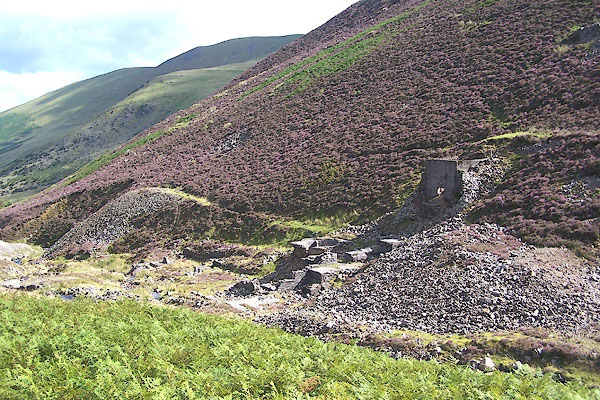
BNY76.jpg Buildings.
(taken 15.8.2007)
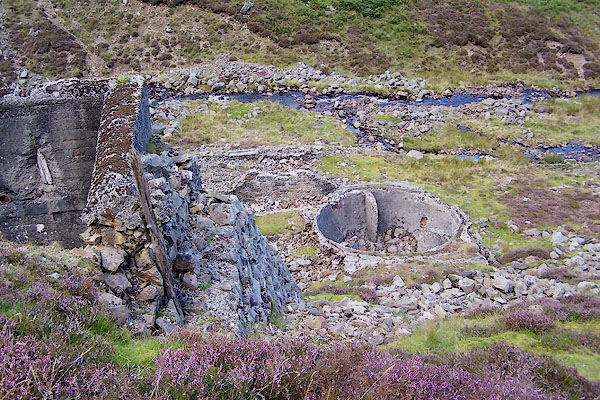
BNY77.jpg Buildings.
(taken 15.8.2007)

GM1407.jpg
"Copper Mines"
item:- Carlisle Library : Map 43
Image © Carlisle Library
 goto source
goto sourcePage 523:- "... Indeed in Brandlegill-beck, and the Northern descents, copper has been formerly dug, but the mines are long since worn out; hereabouts the lapis calaminaris is also found."
item:- geology
 goto source
goto sourcePage 151:- "Carrock Fell consists of a rock generally referred to the class of sienite, varying its appearance in different parts of the mountain. It contains (besides the usual ingredients of quartz and felspar) hypersthene and magnetic or titaniferous iron ore in various proportions. Near this a considerable quantity of lead ore and some copper has been procured: the lead is smelted and refined hard by, and yields a good portion of silver."
placename:- Wolfram Mine
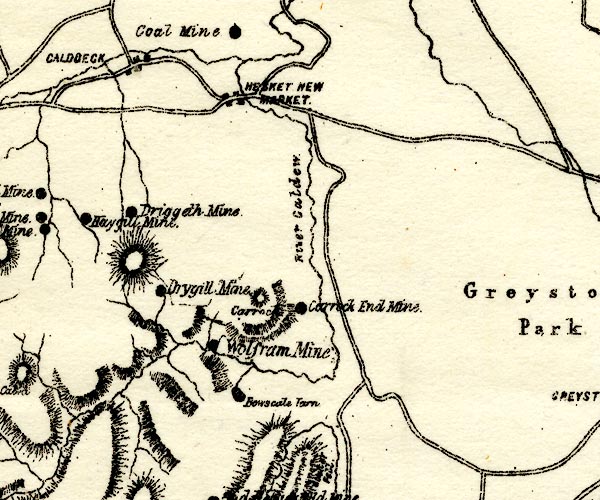
PST2NY33.jpg
"Wolfram Mine"
mine symbol
item:- JandMN : 162.2
Image © see bottom of page
placename:- Carrock Mine
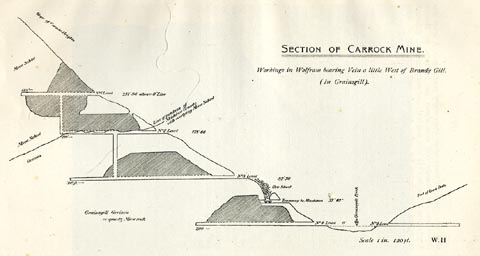 click to enlarge
click to enlargePST332.jpg
On p.131 of Mines and Mining in the English Lake District, by John Postlethwaite.
printed, upper right "SECTION OF CARROCK MINE. / Workings in Wolfram bearing Vein a little West of Brandy Gill. / (In Grainsgill)."
printed, lower right "W.H"
item:- JandMN : 162.34
Image © see bottom of page
placename:- Tungsten Mine
placename:- Wolfram Mine
item:- tungsten ore; wolframite; electric lamp; steel, tungsten; scheelite
 goto source
goto sourcepage 130:- "THE TUNGSTEN OR WOLFRAM MINE."
"One of the most interesting features in the Caldbeck Fells area is the Carrock Tungsten, or Wolfram Mine, it embraces ten or more parallel veins running in a north and south direction, and a multitude of Tungsten bearing strings diverging at various angles. Most of these are exposed more or less on Coombe Height, and in Grainsgill, a tributary of the river Caldew. One of the most important of the veins was worked very early in Brandy Gill, indeed the author has in his possession a specimen of Wolfram"
 goto source
goto sourcepage 132:- "that was obtained there more than sixty years ago. A level was driven on the Brandy Gill vein about 100 fathoms, by Messrs. Emmerson &Co., but the vein was lost, and not recovered, although cross-cuts were driven for some distance east and west at right angles to the course of the vein, which is evidently small underground, but strong and very clearly defined on the surface, where it may be traced right over the fell."
"The metal Wolfram (Tungsteum or Wolframium) is comparatively rare, and is one of the heavy metals, having a specific gravity of 19.1, almost identical with gold, and it requires the intense heat of an electrical furnace for its fusion. In the early days it seems to have been mined almost for the sole purpose of manufacturing Tungstic acid, but in the progress and development of scientific discovery new uses have been found for it, which have increased the demand and largely enhanced its value. It is now largely used in the manufacture of very fine filaments for electric incandescent lamps, for which purpose it is peculiarly adapted owing to its infusibility, or great heat resisting power; it is also used as an alloy of steel."
"The chief minerals from which the metal is derived are Wolframite, an almost coal-black substance; and Scheelite, a yellow waxy mineral, both very heavy. They occur intercrystallized in white opaque quartz veins in the quartz-mica rock (Greisen) of Grainsgill. The rock is a peculiar modification of the Skiddaw Granite of which it is probably a changed condition produced by hydrothermal action. The Wolfram bearing veins also penetrate and are in contact with the cordierite mica schist and dolerite of that area, which is connected on the north with the igneous rocks of Carrock Fell."
"ANALYSIS OF WOLFRAM."
| Tungstic Acid | 78.77 |
| Protoxide of Manganese | 6.22 |
| Protoxide of Iron | 18.32 |
| Silica | 1.25 |
placename:- Carrock Fell Wolfram Mine
placename:- Carrock Mine
item:- wolfram; quartz; mica; muscovite; iron pyrites; arsenic pyrites; scheelite
Geological Outing of the Kendal and District Mine Research Society
Log book page 2:- "DATE - SUNDAY 11/3/79 / MAP REF - NY33 3230 3280 / LOCATION - CARROCK FELL / NAME - CARROCK FELL WOLFRAM MINE / TYPE OF SITE - MINE / WORKING OR DISUSED - WORKING / PEOPLE IN PARTY [ ] / NOS. OF PHOTOS - No.4 / SPECIMENS FOUND - WOLFRAM WITH QUARTZ. LARGE PIECE APPROX 6[in]x6[in] WITH SOME MICA. QUARTZ CRYSTAL. APPROX 4[in] LONG X 3[in] WIDE. MICA. MUSCOVITE. IRON PYRITES ON QUARTZ. ARSENIC PYRITES ON QUARTZ & SOME PIECES OF SCHEELITE / COMMENTS - WENT INTO MINE AT 10.30 AM. SOME WATER ON FLOOR LEVEL, OTHER LEVELS WELL DRAINED. AT ONE POINT HOWEVER WATER CASCADES DOWN A 100 FT CLIMBING LADDER, THAT LEADS TO OTHER HIGHER LEVELS, EVERYONE GOT SOAKED. BUT IT WAS WORTH GETTING WET FOR SPECIMENS & KNOWLEDGE GAINED. WHILST IN ONE OF THE HIGHER LEVELS CHARGES WERE SET AND DETONATED, WITH MULTIPLE EXPLOSIONS THAT SHOOK EVERYTHING &EVERYBODY. CAME OUT AT 1.00 PM. A GOOD DAY HAD BY ALL. THANKS TO [ ] FOR SHOWING US ROUND THE MINE WORKINGS."
item:- private collection : 82
Image © see bottom of page
placename:- Carrock Mine
 click to enlarge
click to enlargeKMR06.jpg
"CARROCK MINE"
item:- private collection : 82
Image © see bottom of page
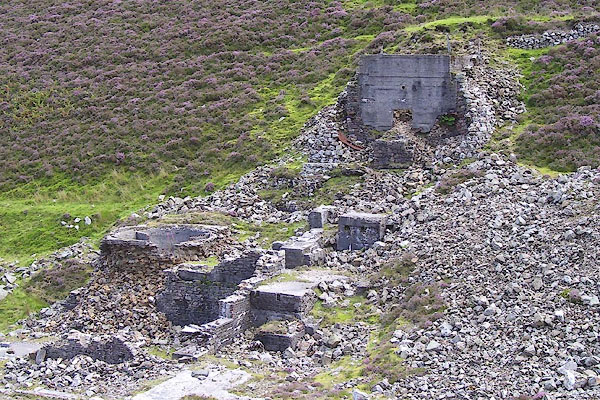
BNY78.jpg Buildings.
(taken 15.8.2007)
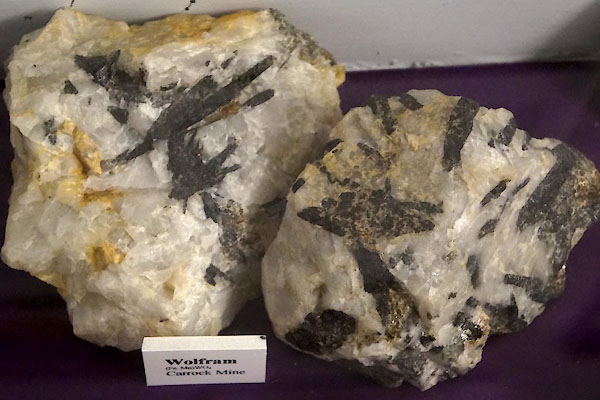
CFJ83.jpg Wolframite.
(taken 23.8.2016) courtesy of Threlkeld Mining Museum
Adams, John: 1988: Mines of the Lake District Fells: Dalesman Books (Lancaster, Lancashire):: ISBN 0 85206 931 6
